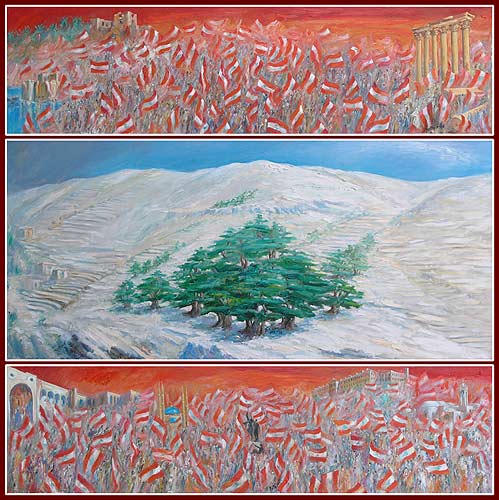The Triptych Lebanese Flag
Brahma, great architect of the world and author of order and harmony,
Vishnu, savior, liberator, and awakener of life in his sleep,
Shiva, who blessed the dormant life aroused by Vishnu and raised it to the attainable heights, these are the three divine aspects of Brahma, who is One.
In India, three periods of festivity are dedicated to them, according to the seasons.
In Christianity we find:
God the Father Almighty, Creator of Time, Space and the Cosmos, of all physical and animated existence,
The Son, the living and merciful Word who poured out his blood for love of mankind and redeemed it,
The Holy Spirit, who is Divine Love and the future self.
In painting, particularly in that of the Middle Ages and in Byzantine art, many triptychs were produced, each one composed of three panels, the outer ones folding on to the central panel. Sculpture also had its equivalent.
Literature, music, and theatre likewise, with works composed of three parts, acts or scenes. In painting, the triptychs were executed in different heights and dimensions, ranging from the miniature to the monumental.
Most often, the subjects treated were religious as a part of sacred art. In the work presented here, the triptych is developed in width.
The subject is again one most sacred, with a national and patriotic theme, the national uprising. The central canvas, where white, blue, gray and green dominate, represents Cornet el Saouda, the highest peak in Lebanon, capped with eternal snow. On the western chain, we see Dahr el Katib, with the white of the country’s flag as snowy undulations with a cliff, terraces and a little village, then cedar trees in the center, a forest but also a tree standing alone. The colored paint flows abundantly and, taking form, is modulated to enclose the abutments of the mountain. The whole is a play of great power and serene virtuosity.
The work is one meter high and 2.10 meters wide. As for the two others, dominated by red and orange and enclosing the central canvas, they are of the same height and have a width of sixty centimeters.
All three are full of movement. In the first one sees Baalbek-Heliopolis, and then to the right and to the left the Citadel of Byblos and the Phoenician port.
What are common to all three are the flags and the movement of the lines that encircle the work and draw the attention. The two canvases are almost monochromatic while still being rich in shades of color, in matter and in dynamism.
In the second canvas, one sees Beiteddine to the left, which follows the diagonal of Heliopolis, then the Martyrs’ Monument in the center, and to the right the great Government House and the church of St. John the Baptist. Everything is brought into harmony by the human movement and the flags which swirl around. This triptych forms our flag and represents our colors.
Joseph MATAR



